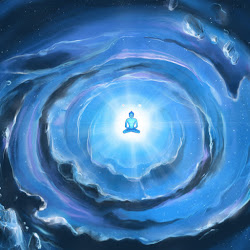Lhündrub Tögal
Lhündrub Tögal (Tibetan: ལྷུན་གྲུབ་ཐོད་རྒལ།, Wylie: lhun grub thod rgal) is a Dzogchen term and practice which holds the semantic field "leaping over", "direct crossing" and "direct approach". The Menngagde or 'Instruction Class' of Dzogchen teachings are, for instruction, divided into two indivisible aspects: Kadag Trekchö and Tögal (thod rgal). The practice of Trekcho is the basis for the practice of Tögal.
Tögal is the practice of "the six lamps" which constitute the preliminaries and the main practice.
The preliminaries constitute the practice of separating samsara and nirvana, "djungne-drosom".
The term 'lamp' connotes something that dispels darkness and refers to the illuminating quality of the practitioner's basic nature. This lamp has six aspects:
The Basis
In the basis (Tibetan: གཞི, Wylie: gzhi) there were neutral awarenesses (sh shes pa lung ma bstan) that did not recognize themselves. (Dzogchen texts actually do not distinguish whether this neutral awareness is one or multiple.) This non-recognition was the innate ignorance. Due to traces of action and affliction from a previous universe, the basis became stirred and the Five Pure Lights shone out. When a neutral awareness recognized the lights as its own display, that was Samantabhadra (immediate liberation without the performance of virtue). Other neutral awarenesses did not recognize the lights as their own display, and thus imputed “other” onto the lights. This imputation of “self” and “other” was the imputing ignorance. This ignorance started sentient beings and samsara (even without non-virtue having been committed).
Practice
The Dzogchenpa through sadhana engenders stability in abiding in the nature of mind through the discipline of Trekcho and with this as foundation and support, may progress the refinement of Togal. Whilst Trekcho reveals the nature of the Dharmakaya, Togal reveals the Sambhogakaya and Nirmanakaya. The discipline of Togal employs refined 'forms' (Tibetan: གནད, Wylie: gnad) of 'bodily posture' (Sanskrit: asana, mudra and bandha) and 'visual focus' or 'gaze' (Sanskrit: drishti) to incite four specific visionary experiences.
In the following quotation of Pettit (1999: p. 80), 'mantric syllables' are bija, and the 'buddha paradises' are Pure land:
- "In the four visions of all-surpassing realization gnosis manifests spontaneously as visions of spheres of light containing mantric syllables and images of buddhas, "vajra chains" (rdo rje lug gu rgyud), and buddha paradises (zhing khams). After these visions reach the limit of diversity and completeness, all appearances recede in the ground of reality (dharmatã, chos nyid), and the perfection of the three buddha bodies is attained trikaya."
In Dzogchen teachings, "dharmakaya" means the Buddha-nature's absence of self-nature, that is, its emptiness of a conceptualizable essence, its cognizance or clarity is the sambhogakaya, and the fact that its capacity is 'suffused with self-existing awareness' is the nirmanakaya.
Thödgal represents more a fruition than a practice itself. Furthermore, there are methods prepared in the event of a psychotic break to bring the practitioner back to sanity.
In contrast to other kinds of tantric practices, there is no intentional visualization; rather, imagery appears spontaneously. Eventually a practitioner has experiences which are viewed as knowing the subtle energies of one's being. These have the qualities of earth, water, fire, air and space (see Classical element). Throughout the retreat, a practitioner is believed to be approaching an experience which is entirely unconditioned.
